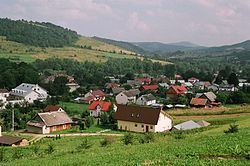Founded 1615 Area 68.8 km² | Elevation 340 m (1,120 ft) Local time Wednesday 12:06 AM | |
 | ||
Weather 9°C, Wind S at 16 km/h, 60% Humidity | ||
Baligród [baˈlʲiɡrut] (Ukrainian: Балигород, Balyhorod) is a village in Lesko County, in the Subcarpathian Voivodeship (province) of south-eastern Poland. It is also the seat of the municipality (gmina) called Gmina Baligród. Location: 49°21' N 22°17' E. From 1 January 1999 until 1 January 2002 it was located in Bieszczady County.
Contents
Map of Baligr%C3%B3d, Poland
History
Baligród is a village situated in the valley of the Hoczewka river, near the Bieszczady mountains. Earlier Baligród was a small town but declined in population over the last century.
The settlement was first mentioned in 1615. It is believed to have been established at the beginning of the 17th century near a castle built by the Bal family. In 1634 the town previously called Balówgród received Magdeburg rights and privileges for markets, fairs and wine storage. Baligród remained in the Bal family until 1770. The town was situated on an often traveled trade route to Hungary. This enhanced opportunities for greater economic development. However the town began to later decline and in 1915 lost its municipal rights. The Baligród region was home to a large Ukrainian community, consisting of Lemkos and Boykos.
Between 1914 and 1915, during World War I, Baligród was partially destroyed. During World War II the village was once again partially damaged and many of its inhabitants were killed.
Between 1944-1946 many members of the Ukrainian minority in Poland were forcibly repatriated from Poland to the Soviet Union (Ukrainian SSR and Siberia). On 28 March 1947, Polish General Karol Świerczewski was killed nearby on a road to Cisna, close to Jabłonki, by members of the Ukrainian Insurgent Army. In 1947 the People's Republic of Poland conducted Operation Vistula in an effort to eliminate the Ukrainian Ingurgency's support base. The remnants of the region's Ukrainian population were relocated to the Recovered Territories.
It is a village with a few stores and homes built around a large square. In the middle of the square is a model of a T-34 tank. The tank was used in skirmishes against the Ukrainian Insurgent Army in the Bieszczady mountains. An earlier monument of a T-70 tank in Baligród was the last one its kind existing in Poland but was transferred to the armour museum of the Centrum Szkolenia Wojsk Lądowych (Land Forces Training Centre) in Poznań.
The ancestors of Michael Schudrich, the Chief Rabbi of Poland, were born in Baligród.
